engine SUBARU LEGACY 2005 4.G Owners Manual
[x] Cancel search | Manufacturer: SUBARU, Model Year: 2005, Model line: LEGACY, Model: SUBARU LEGACY 2005 4.GPages: 627, PDF Size: 6.42 MB
Page 5 of 627

2
How to use this owner’s manual !Using your Owner’s manual
Before you operate your vehicle, carefully read this
manual. To protect yourself and extend the service life
of your vehicle, follow the instructions in this manual.
Failure to observe these instructions may result in se-
rious injury and damage to your vehicle.
This manual is composed of fourteen chapters. Each
chapter begins with a brief table of contents, so you
can usually tell at a glance if that chapter contains the
information you want.
Chapter 1: Seat, seatbelt and SRS airbags
This chapter informs you how to use the seat and seat-
belt and contains precautions for the SRS airbags.
Chapter 2: Keys and doors
This chapter informs you how to operate the keys,
locks and windows.
Chapter 3: Instruments and controls
This chapter informs you about the operation of instru-
ment panel indicators and how to use the instruments
and other switches.
Chapter 4: Climate control
This chapter informs you how to operate the climate
control.
Chapter 5: Audio This chapter informs you how to operate your audiosystem.
Chapter 6: Interior equipment
This chapter informs you how to operate interior
equipment.
Chapter 7: Starting and operating
This chapter informs you how to start and operate your SUBARU.
Chapter 8: Driving tips
This chapter informs you how to drive your SUBARU
in various conditions and explains some safety tips on
driving.
Chapter 9: In case of emergency
This chapter informs you what to do if you have a prob-
lem while driving, such as a flat tire or engine over-
heating.
Chapter 10: Appearance care
This chapter informs you how to keep your SUBARU
looking good.
Chapter 11: Maintenance and service
This chapter informs you when you need to take your
SUBARU to the dealer for scheduled maintenance
and informs you how to keep your SUBARU running
properly.
Chapter 12: Specifications
This chapter informs you about dimension and capac-
ities of your SUBARU.
Page 8 of 627
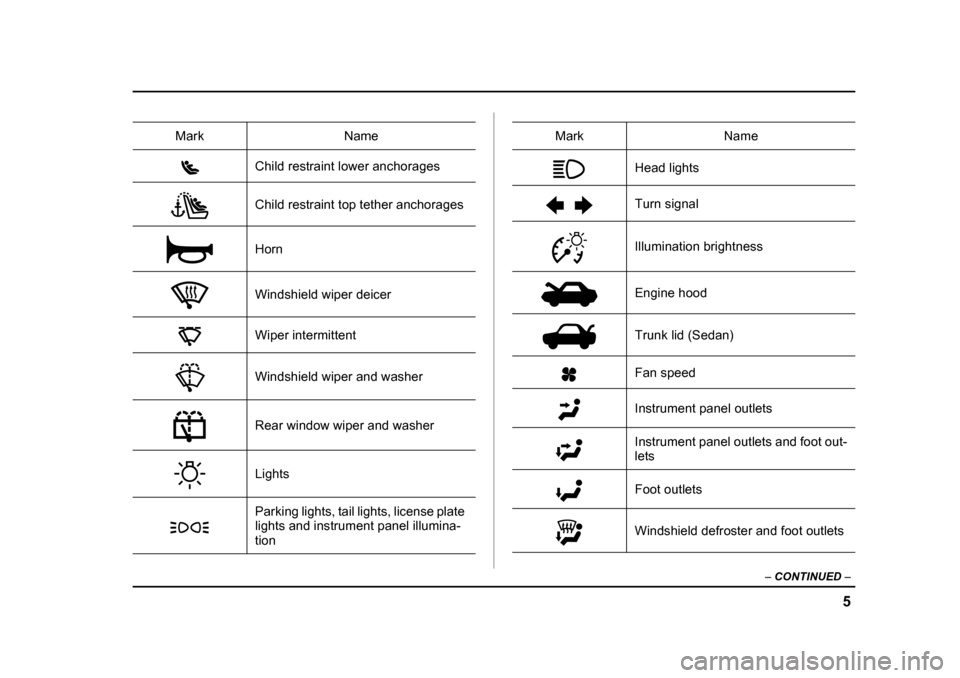
5
–
CONTINUED –
Child restraint lower anchorages
Child restraint top tether anchorages
Horn
Windshield wiper deicer
Wiper intermittent
Windshield wiper and washer
Rear window wiper and washerLights
Parking lights, tail lights, license plate
lights and instrument panel illumina-tion
Mark NameHead lights
Turn signal
Illumination brightness
Engine hood
Trunk lid (Sedan)
Fan speed
Instrument panel outlets
Instrument panel outlets and foot out- lets
Foot outlets
Windshield defroster and foot outlets
Mark Name
Page 9 of 627
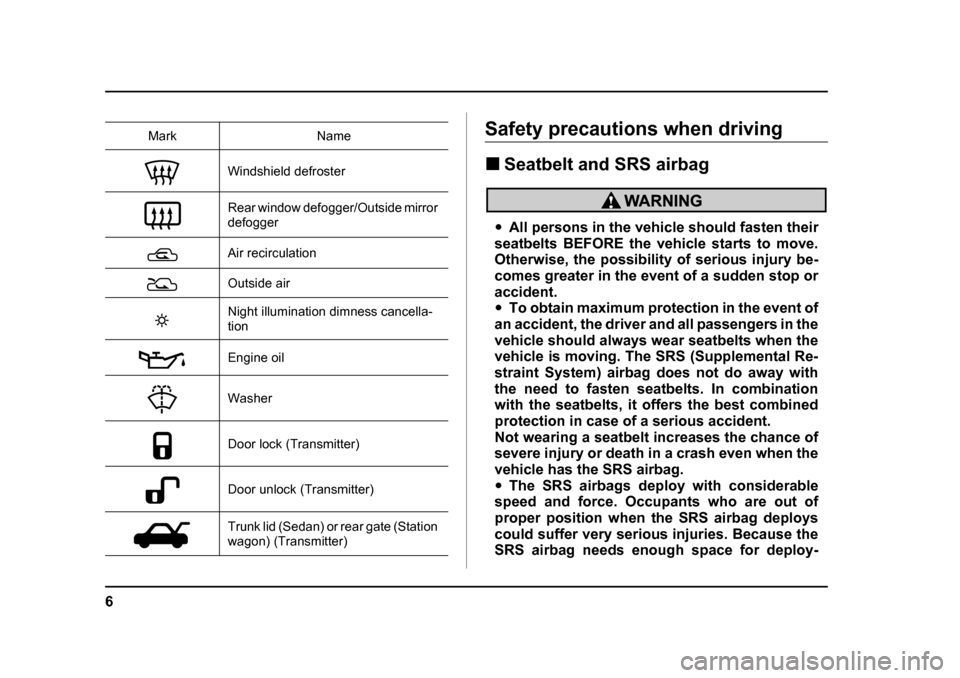
6
Safety precautions when driving !Seatbelt and SRS airbag
"All persons in the vehicle should fasten their
seatbelts BEFORE the vehicle starts to move.
Otherwise, the possibility of serious injury be-
comes greater in the event of a sudden stop or
accident." To obtain maximum protection in the event of
an accident, the driver and all passengers in the
vehicle should always wear seatbelts when the
vehicle is moving. The SRS (Supplemental Re-
straint System) airbag does not do away with
the need to fasten seatbelts. In combination
with the seatbelts, it offers the best combined
protection in case of a serious accident.
Not wearing a seatbelt increases the chance of
severe injury or death in a crash even when the
vehicle has the SRS airbag. " The SRS airbags deploy with considerable
speed and force. Occupants who are out of
proper position when the SRS airbag deploys
could suffer very serious injuries. Because the
SRS airbag needs enough space for deploy-
Windshield defroster
Rear window defogger/Outside mirror
defogger
Air recirculation
Outside air
Night illumination dimness cancella- tion
Engine oil Washer
Door lock (Transmitter)
Door unlock (Transmitter)
Trunk lid (Sedan) or rear gate (Station
wagon) (Transmitter)
Mark Name
Page 11 of 627
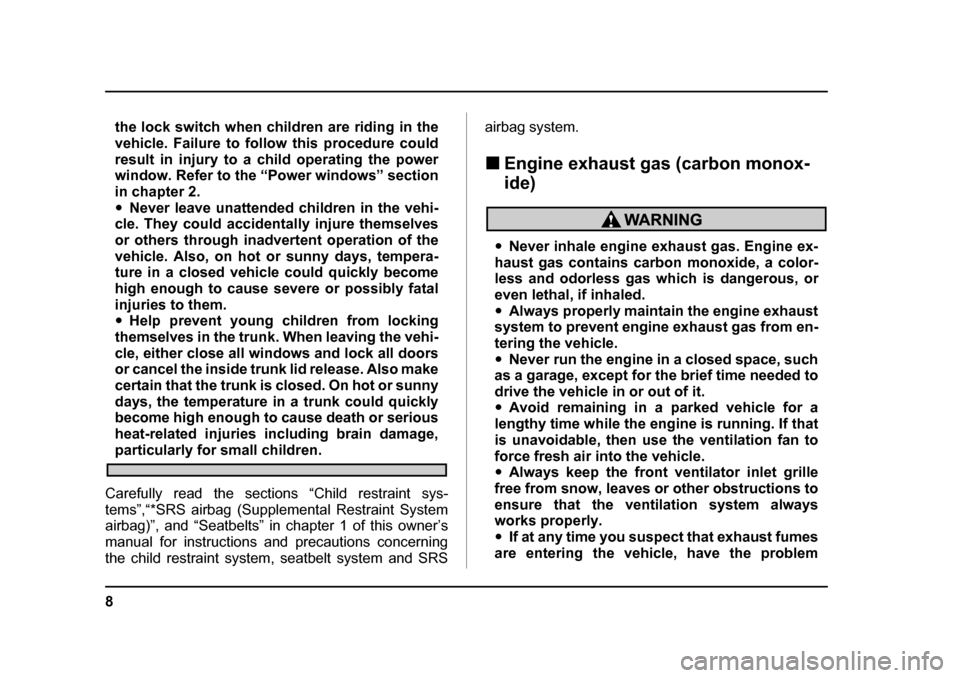
8
the lock switch when children are riding in the
vehicle. Failure to follow this procedure could
result in injury to a child operating the power
window. Refer to the “Power windows” section
in chapter 2."Never leave unattended children in the vehi-
cle. They could accidentally injure themselves
or others through inadvertent operation of the
vehicle. Also, on hot or sunny days, tempera-
ture in a closed vehicle could quickly become
high enough to cause severe or possibly fatal
injuries to them. " Help prevent young children from locking
themselves in the trunk. When leaving the vehi-
cle, either close all windows and lock all doors
or cancel the inside trunk lid release. Also make
certain that the trunk is closed. On hot or sunny
days, the temperature in a trunk could quickly
become high enough to cause death or serious
heat-related injuries including brain damage,
particularly for small children.
Carefully read the sections “Child restraint sys-
tems”,“*SRS airbag (Supplemental Restraint System
airbag)”, and “Seatbelts” in chapter 1 of this owner’s
manual for instructions and precautions concerning
the child restraint system, seatbelt system and SRS airbag system. !
Engine exhaust gas (carbon monox- ide)
"Never inhale engine exhaust gas. Engine ex-
haust gas contains carbon monoxide, a color-
less and odorless gas which is dangerous, or
even lethal, if inhaled. " Always properly maintain the engine exhaust
system to prevent engine exhaust gas from en-
tering the vehicle. " Never run the engine in a closed space, such
as a garage, except for the brief time needed to
drive the vehicle in or out of it. " Avoid remaining in a parked vehicle for a
lengthy time while the engine is running. If that
is unavoidable, then use the ventilation fan to
force fresh air into the vehicle. " Always keep the front ventilator inlet grille
free from snow, leaves or other obstructions to
ensure that the ventilation system always
works properly. " If at any time you suspect that exhaust fumes
are entering the vehicle, have the problem
Page 14 of 627
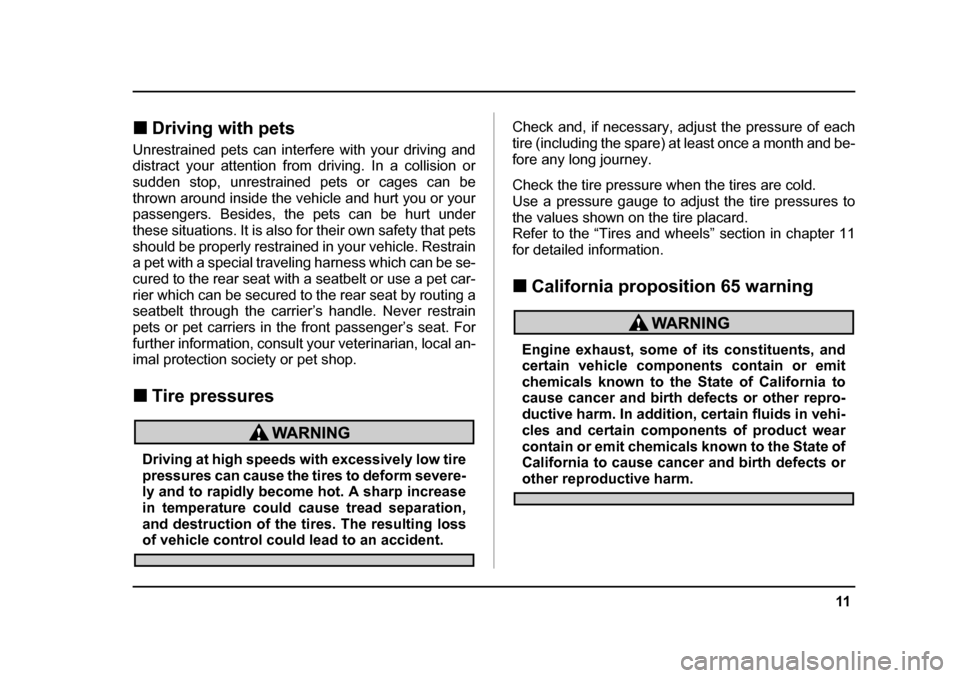
11
–
CONTINUED –
!Driving with pets
Unrestrained pets can interfere with your driving and
distract your attention from driving. In a collision or
sudden stop, unrestrained pets or cages can be
thrown around inside the vehicle and hurt you or your
passengers. Besides, the pets can be hurt under
these situations. It is also for their own safety that pets
should be properly restrained in your vehicle. Restrain
a pet with a special traveling harness which can be se-
cured to the rear seat with a seatbelt or use a pet car-
rier which can be secured to the rear seat by routing a
seatbelt through the carrier’s handle. Never restrain
pets or pet carriers in the front passenger’s seat. For
further information, consult your veterinarian, local an-
imal protection society or pet shop. ! Tire pressures
Driving at high speeds with excessively low tire
pressures can cause the tires to deform severe-
ly and to rapidly become hot. A sharp increase
in temperature could cause tread separation,
and destruction of the tires. The resulting loss
of vehicle control could lead to an accident. Check and, if necessary, adjust the pressure of each
tire (including the spare) at least once a month and be-
fore any long journey.
Check the tire pressure when the tires are cold.
Use a pressure gauge to adjust the tire pressures to
the values shown on the tire placard.
Refer to the “Tires and wheels” section in chapter 11
for detailed information. !
California proposition 65 warning
Engine exhaust, some of its constituents, and
certain vehicle components contain or emit
chemicals known to the State of California to
cause cancer and birth defects or other repro-
ductive harm. In addition, certain fluids in vehi-
cles and certain components of product wear
contain or emit chemicals known to the State of
California to cause cancer and birth defects or
other reproductive harm.
Page 17 of 627
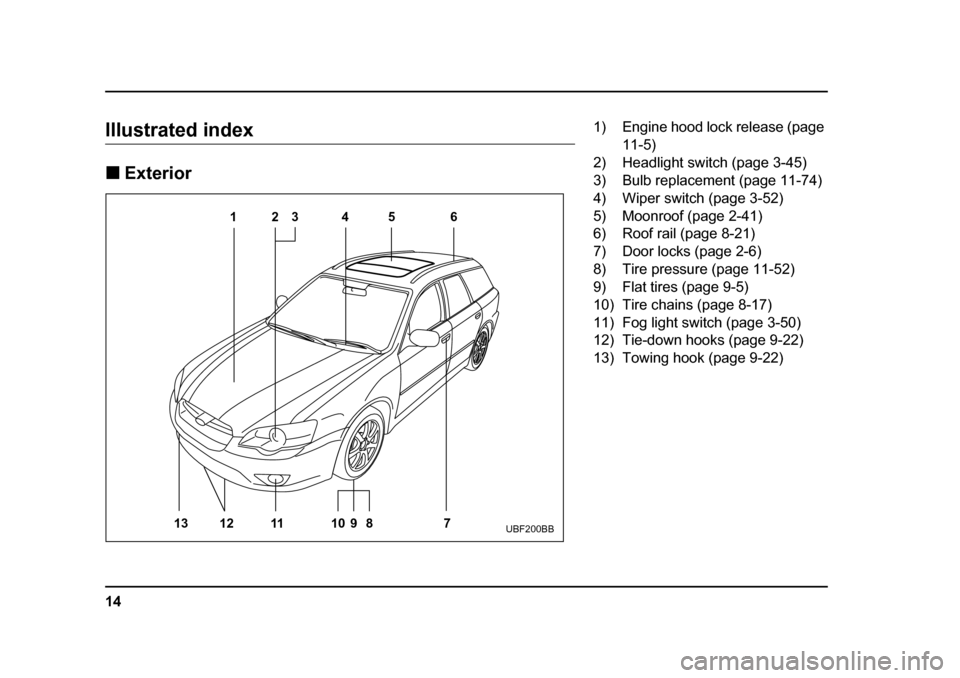
14
Illustrated index !Exterior
123 5 6 4
13 11 12 89 10 7
UBF200BB
1) Engine hood lock release (page
11-5)
2) Headlight switch (page 3-45)
3) Bulb replacement (page 11-74)
4) Wiper switch (page 3-52)
5) Moonroof (page 2-41)
6) Roof rail (page 8-21)
7) Door locks (page 2-6)
8) Tire pressure (page 11-52)
9) Flat tires (page 9-5)
10) Tire chains (page 8-17)
11) Fog light switch (page 3-50)
12) Tie-down hooks (page 9-22)
13) Towing hook (page 9-22)
Page 26 of 627
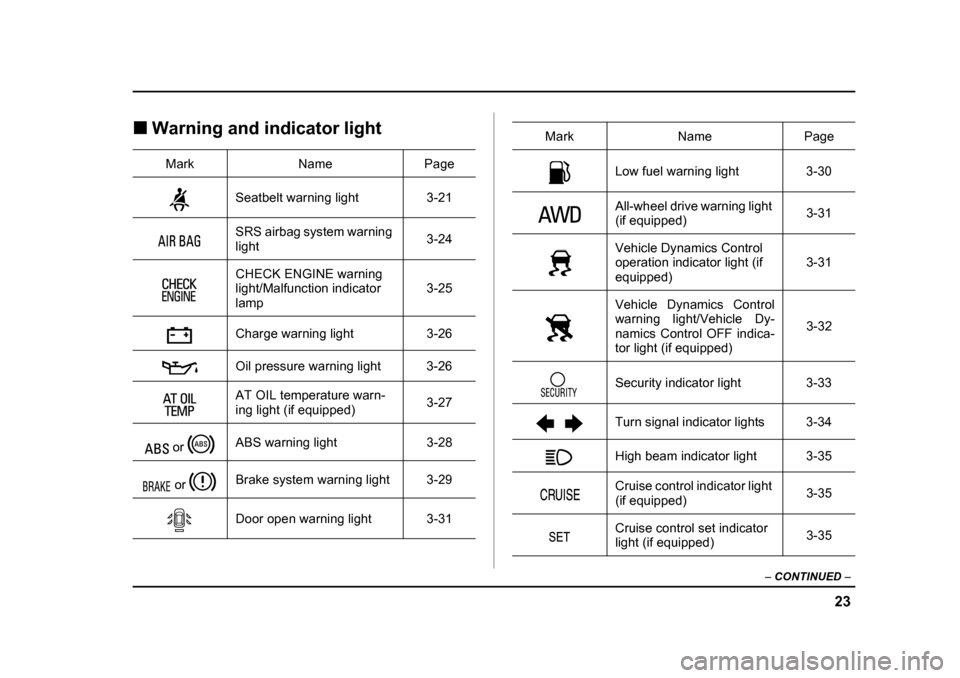
23
–
CONTINUED –
!Warning and indicator light
Mark Name Page
Seatbelt warning light 3-21
SRS airbag system warning light 3-24
CHECK ENGINE warning
light/Malfunction indicator lamp 3-25
Charge warning light 3-26
Oil pressure warning light 3-26
AT OIL temperature warn-
ing light (if equipped) 3-27
or ABS warning light 3-28
or Brake system warning light 3-29
Door open warning light 3-31
Low fuel warning light 3-30
All-wheel drive warning light (if equipped) 3-31
Vehicle Dynamics Control
operation indicator light (if equipped) 3-31
Vehicle Dynamics Control
warning light/Vehicle Dy-
namics Control OFF indica-tor light (if equipped) 3-32
Security indicator light 3-33
Turn signal indicator lights 3-34
High beam indicator light 3-35
Cruise control indicator light (if equipped) 3-35
Cruise control set indicator
light (if equipped) 3-35
Mark Name Page
Page 41 of 627
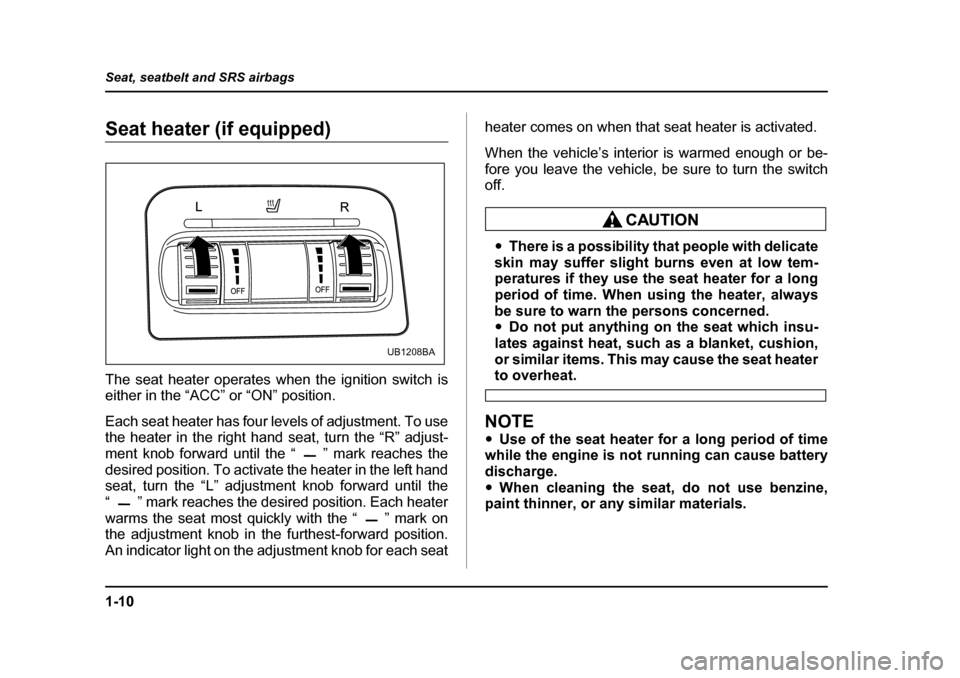
1-10
Seat, seatbelt and SRS airbags
Seat heater (if equipped)
The seat heater operates when the ignition switch is
either in the “ACC” or “ON” position.
Each seat heater has four levels of adjustment. To use
the heater in the right hand seat, turn the “R” adjust-
ment knob forward until the “ ” mark reaches the
desired position. To activate the heater in the left hand
seat, turn the “L” adjustment knob forward until the
“ ” mark reaches the desired position. Each heater
warms the seat most quickly with the “ ” mark on
the adjustment knob in the furthest-forward position.
An indicator light on the adjustment knob for each seat
heater comes on when that seat heater is activated.
When the vehicle’s interior is warmed enough or be-
fore you leave the vehicle, be sure to turn the switch
off.
"
There is a possibility that people with delicate
skin may suffer slight burns even at low tem-
peratures if they use the seat heater for a long
period of time. When using the heater, always
be sure to warn the persons concerned. " Do not put anything on the seat which insu-
lates against heat, such as a blanket, cushion,
or similar items. This may cause the seat heater
to overheat.
NOTE " Use of the seat heater for a long period of time
while the engine is not running can cause battery
discharge." When cleaning the seat, do not use benzine,
paint thinner, or any similar materials.
UB1208BA
Page 129 of 627
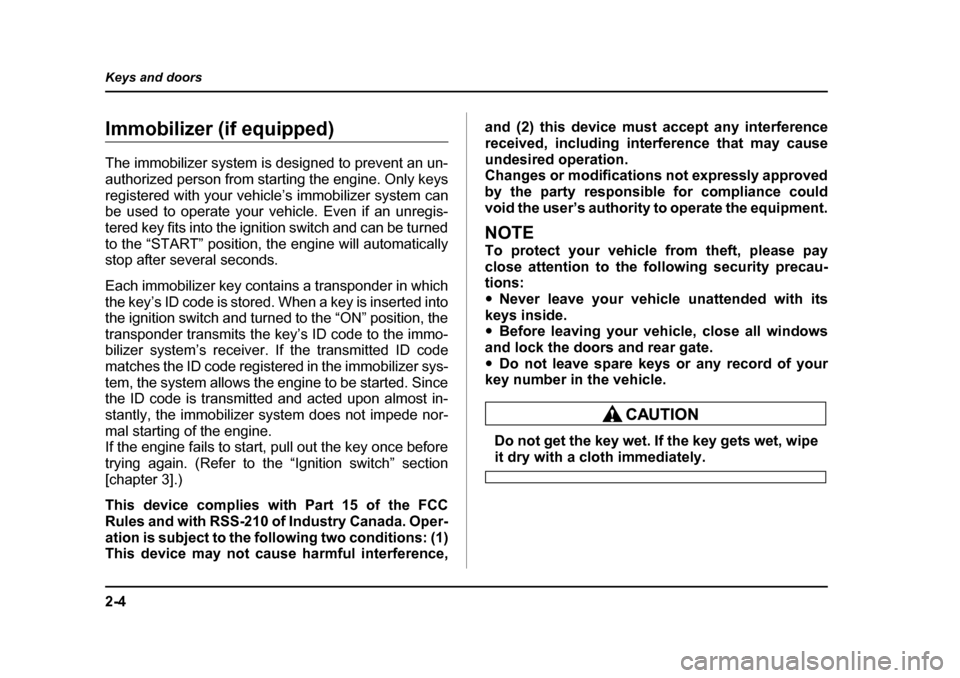
2-4
Keys and doors
Immobilizer (if equipped)
The immobilizer system is designed to prevent an un-
authorized person from starting the engine. Only keys
registered with your vehicle’s immobilizer system can
be used to operate your vehicle. Even if an unregis-
tered key fits into the ignition switch and can be turned
to the “START” position, the engine will automatically
stop after several seconds.
Each immobilizer key contains a transponder in which
the key’s ID code is stored. When a key is inserted into
the ignition switch and turned to the “ON” position, the
transponder transmits the key’s ID code to the immo-
bilizer system’s receiver. If the transmitted ID code
matches the ID code registered in the immobilizer sys-
tem, the system allows the engine to be started. Since
the ID code is transmitted and acted upon almost in-
stantly, the immobilizer system does not impede nor-
mal starting of the engine.
If the engine fails to start, pull out the key once before
trying again. (Refer to the “Ignition switch” section [chapter 3].)
This device complies with Part 15 of the FCC
Rules and with RSS-210 of Industry Canada. Oper-
ation is subject to the following two conditions: (1)
This device may not cause harmful interference,
and (2) this device must accept any interference
received, including interference that may cause
undesired operation.
Changes or modifications not expressly approved
by the party responsible for compliance could
void the user’s authority to operate the equipment.
NOTE
To protect your vehicle from theft, please pay
close attention to the following security precau- tions: "
Never leave your vehicle unattended with its
keys inside. " Before leaving your vehicle, close all windows
and lock the doors and rear gate. " Do not leave spare keys or any record of your
key number in the vehicle.
Do not get the key wet. If the key gets wet, wipeit dry with a cloth immediately.
Page 130 of 627
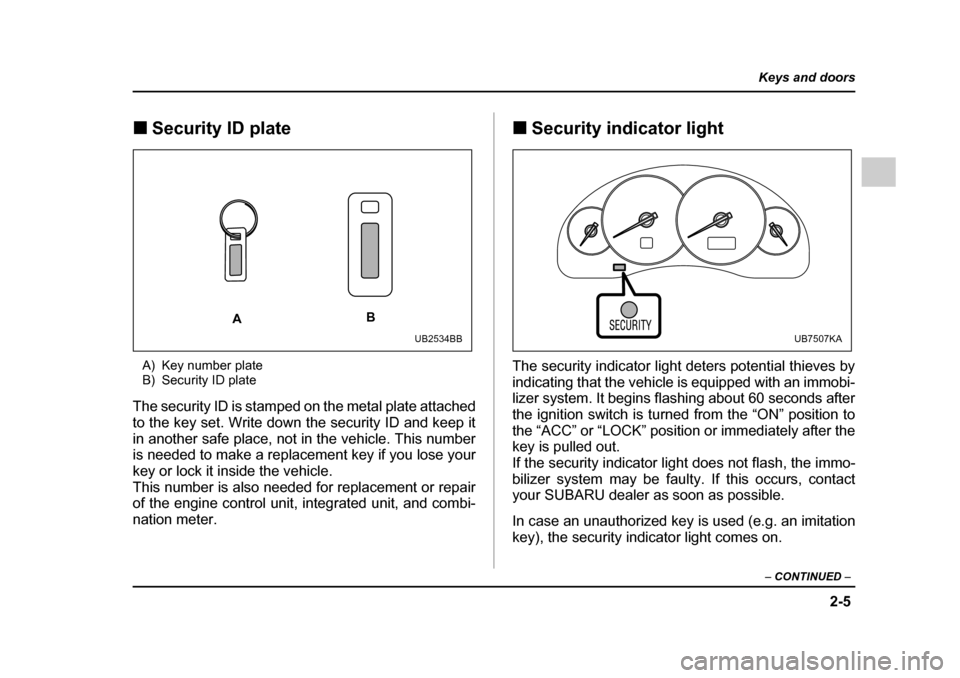
2-5
Keys and doors
– CONTINUED –
!Security ID plate
A) Key number plate
B) Security ID plate
The security ID is stamped on the metal plate attached
to the key set. Write down the security ID and keep it
in another safe place, not in the vehicle. This number
is needed to make a replacement key if you lose your
key or lock it inside the vehicle.
This number is also needed for replacement or repair
of the engine control unit, integrated unit, and combi- nation meter. !
Security indicator light
The security indicator light deters potential thieves by
indicating that the vehicle is equipped with an immobi-
lizer system. It begins flashing about 60 seconds after
the ignition switch is turned from the “ON” position to
the “ACC” or “LOCK” position or immediately after the
key is pulled out.
If the security indicator light does not flash, the immo-
bilizer system may be faulty. If this occurs, contact
your SUBARU dealer as soon as possible.
In case an unauthorized key is used (e.g. an imitation
key), the security indicator light comes on.
A B
UB2534BBUB7507KA